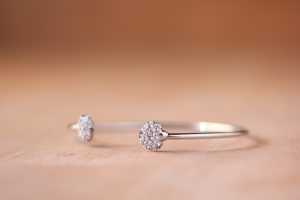Special Metals: White Gold, Silver, Platinum
Jewelry features a vast range of gemstones, and utilizes a wide range of precious metals. Three of the precious metals include white gold, silver, and platinum. They all have their specific uses and benefits over the more traditional metal, yellow gold.
What Makes White Gold
Colored gold is in. Just look at all the people walking around with their Rose Gold iPhones! When it comes to jewelry, colored gold is an amazing flair that can make a piece even more unique and beautiful. But what goes into making gold a color other than lustrous yellow?
While gold, pure gold that is, is reddish yellow there are a number of variations in colors that can occur. When another metal or similar compound is mixed with the gold the range of color for gold is opened. For white gold in particular that means nickel or palladium amongst others.
Pure, 100% gold of course sits at 24 karat, while any further mix of metals will lower the karat of the gold. The makeup of this alloy can affect several different properties in the jewelry. Some variants of white gold, those that are made with nickel are a harder, stronger material and as such are perfect for rings or pins.
All of that said, the most common alloy for white gold is a 90% gold and 10% nickel combination, while jewelry features more gold/nickel/copper/zinc and gold/palladium/silver alloys.
Silver
As one of the few metals of the ancient world, silver has long been used in the fashioning of jewelry. Pure silver is a very soft metal. To support it better, it is often used in an alloy with copper.
Silver does unfortunately have the quality of being easily tarnished by certain compounds. It helps to alloy it other metals such as zinc.
Silver is an eternally stylish metal for jewelry, being less flashy than gold but with a similar prestige.
Platinum
Platinum is one the ‘newer’ precious metals in use, having only been discovered by the Western world as settlers arrived in South America and found it being used by native peoples. Platinum is a less commonly used metal in jewelry, being 30 times rarer than gold, and as such brings an air of exclusivity to a piece. It also is a stronger and more durable metal than gold, and it brings that quality to any jewelry that uses it. Platinum is dense. When scratched for instance, platinum doesn’t lose the metal, it is simply displaced. Platinum is meant to last and its coloring doesn’t fade like some white gold alloys.
With these three metals, all being a distinct departure from traditional gold jewelry, they can really elevate any piece with their exceptional brilliance. If you are looking to purchase jewelry that stands apart, platinum, white gold, and silver are all great options.
Give us a call and we can help you find the perfect piece, or create your own unique item.



